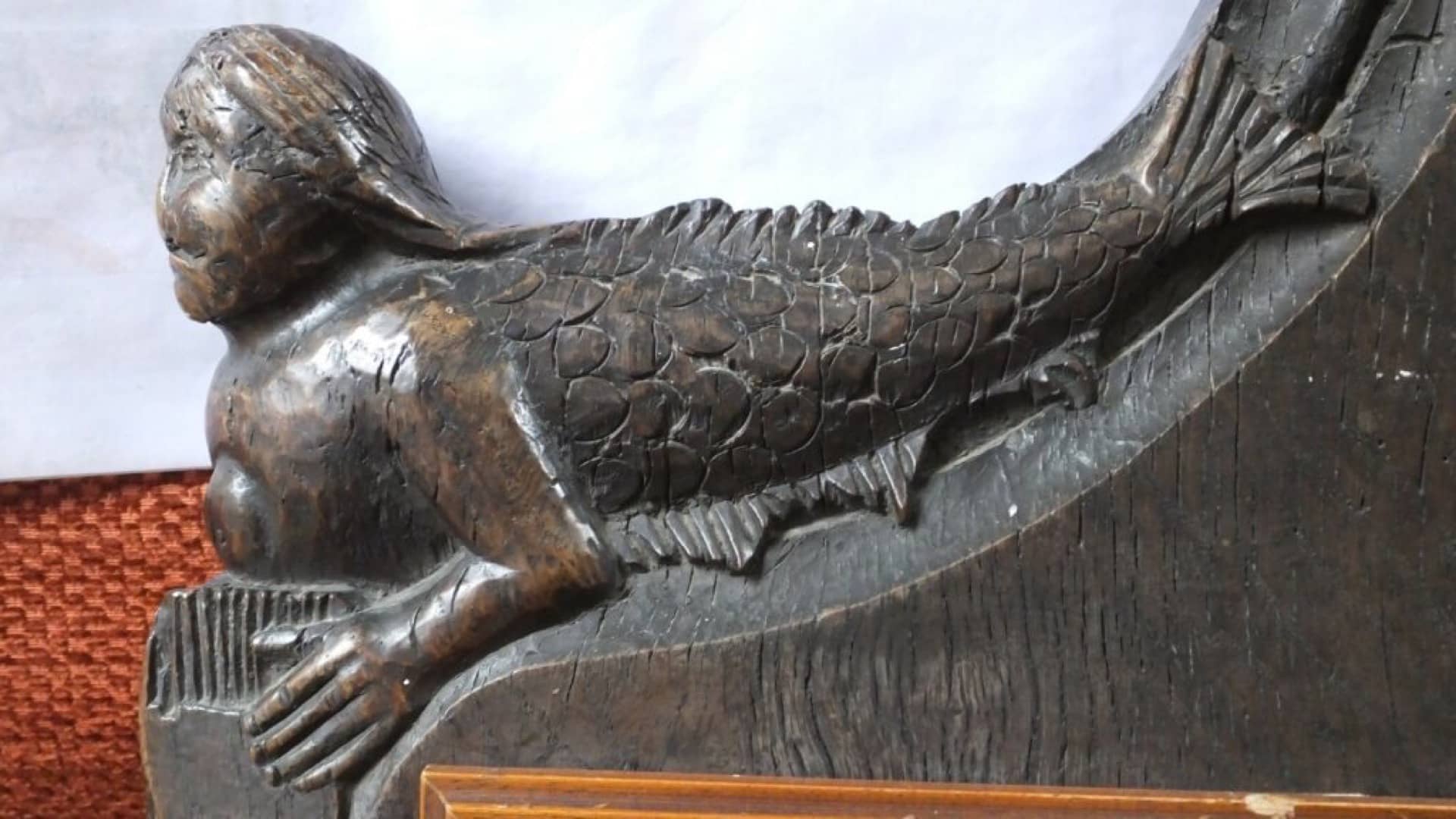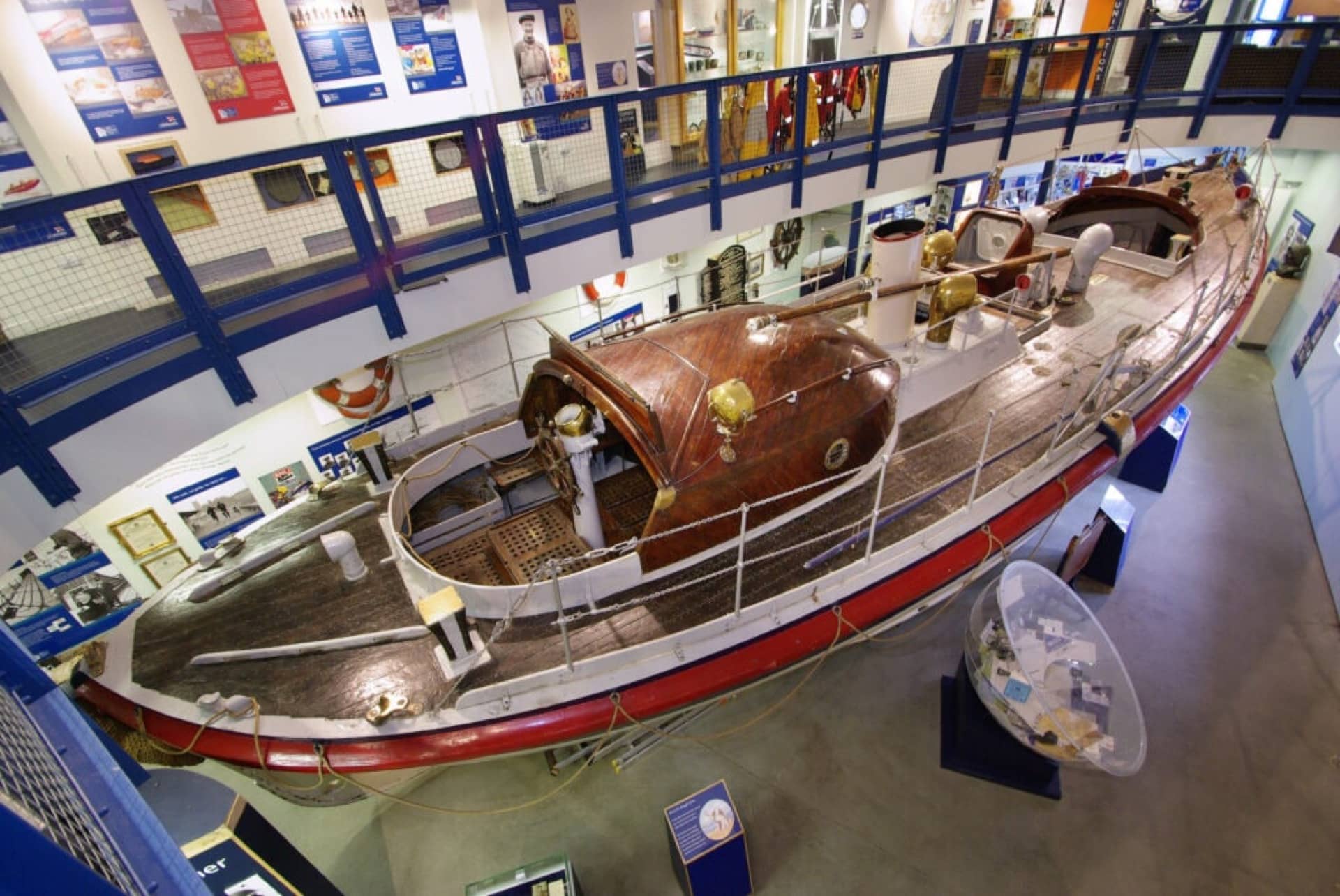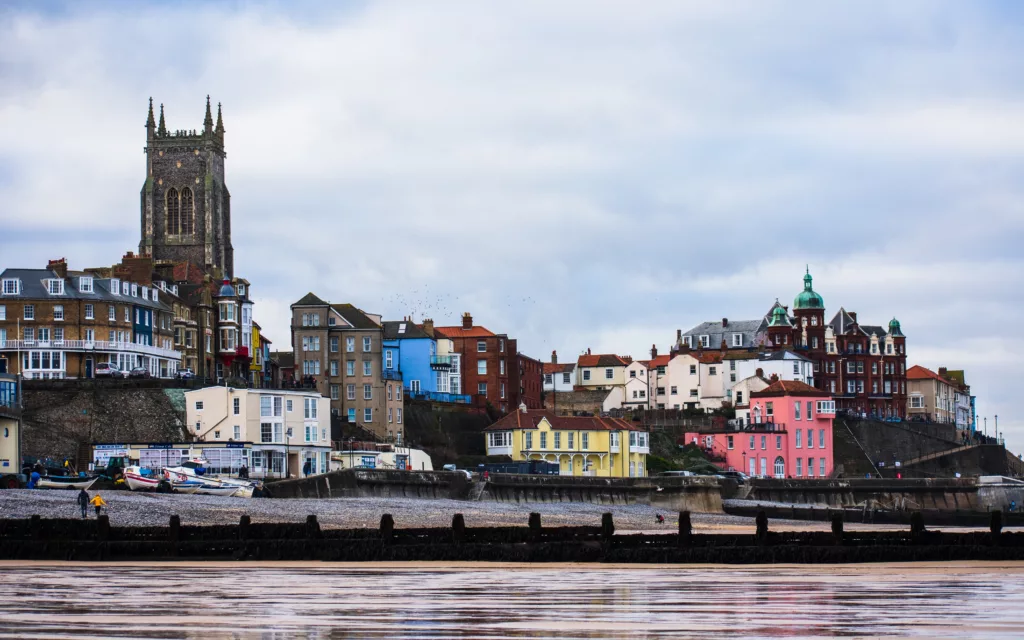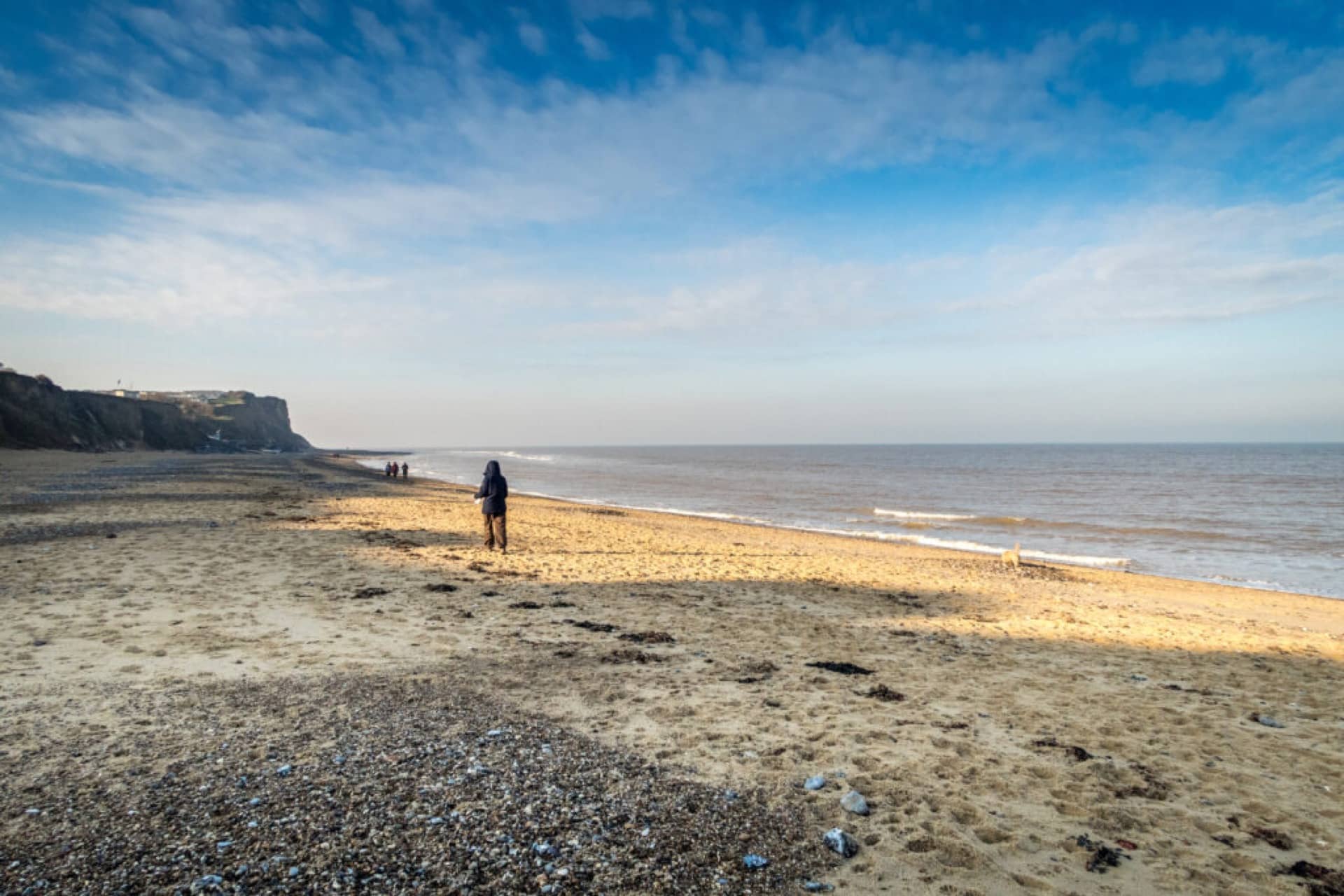
Sheringham Mermaid
On a sandbank off Sheringham, a mermaid sang to the wandering stars, forlorn and all alone. One winter night it seemed her searching voice heard an answering call. Echoing through the streets came the sweet sound of human voices raised in harmony amid cascading peals of church bells. Enchanted, she hauled herself onto the pebble beach. Her silvery fish’s tail was cumbersome in the cold air, but the singing was so beautiful she dragged her body inch by inch over the rough streets and into the church.
But these were fishing folk and mermaids are unpredictable creatures, agents of both fortune and disaster, changeable as the sea. Besides, they have no immortal soul. So the people were afraid and cast her out.
When they’d gone, she crept back into the church. And she’s there still. At All Saints in Upper Sheringham you’ll find a mermaid carved into the end of a 15th century pew. Perhaps angels took pity on the sea nymph’s lonely heart and, as wooden figureheads guide ships to harbour, they brought her safely home.
If you want to be sure of getting home safely, listen for the Yow Yows. That’s Sheringham’s term for a sudden squall, named after uncanny sounds shifting across the waves before storms strike. Some say it’s the drowned voice of an old sea captain still cursing local fishermen who let him perish. If you hear cries of eternal distress, return immediately to shore, for his warning is an omen of doom

Sheringham Park: A Vision in a Red Leather Book
Looking for Norfolk’s best winter walks? Try Sheringham Park. Rolling over nearly 1,000 acres of landscaped parkland and wooded glades it was designed by Humphry Repton to frame some of Britain’s most magnificent sea views.
Repton’s landscape proposals of 1812 are documented in one of his famous red leather books of which only 200 survive. He wrote ‘Sheringham possesses more natural beauty and local advantages than any other place I have ever seen’. Thus enchanted, Sheringham Park stands as one of the finest examples of Humphry Repton’s work and vibrant source of inspiration for landscape designers. Many of his plans were implemented by others, but Sheringham is true to Repton’s original vision; perhaps that’s why it was one of his favourites.
Paths meander through magical woodlands, farmland and down to coastal cliffs, glorious walking all year round. In late spring, shiny evergreen rhododendrons burst into gorgeous bloom, starred with abundant azaleas. Hot pink, bright orange, sassy purple, aflame with showy reckless energy. No wonder the Victorians associated them with danger as well as passion and abundance! See the clouds of vibrant colour from the tree-top tower which gives a 360º view of the park.
Four routes explore different aspects of this idyllic Victorian landscape. Time the Red Route to meet the steam train at Weybourne Station for a heritage ride back to Sheringham. Sheringham Park is brilliantly accessible for disabled visitors, with hearing loops, large print maps, Braille guides, wheelchairs and battery powered vehicles available at the Visitor Centre.

The Cromer lifeboatman, Henry Blogg
In every coastal community courageous souls set sail into terrifying storms when inland folk stay safe at home. Among the most famous of them all is Henry Blogg, Coxswain of the Cromer Lifeboat. By trade this modest, quiet-living fellow was a crab fisherman. In summer he rented out deck chairs and beach huts. But it was in rougher weather he made his name as ‘One of the Bravest Men who Ever Lived’.
He won the RNLI gold medal for conspicuous gallantry 3 times and the silver medal 4 times, plus the George Cross for general war service and a British Empire Medal, making him the most decorated lifeboatman in RNLI history. A national hero, commended for remarkable leadership, he celebrated the ‘dogged tenacity’ of his crew and kept the medals in his sideboard, rarely worn.
A lifeboatman since 1909, his first medals were won in 1917 when the Cromer’s lifeboat, Louisa Heartwell, launched 4 times in a relentless storm, to rescue 22 crew onboard the Pyrin, a Greek vessel. Looking forward to bowls of hot soup and a good rest after 14 hours at sea, they learned a Swedish ship Fernabo, had been blown in two by a floating mine. Rowing out more 3 times, it took another 24 hours to save the the stricken men.
By the time Henry retired aged 74 after 53 years of service, he’d saved 873 lives.

Fishermen and Kings: Olive Edis
Like an old photograph, the name Olive Edis had faded from memory. Yet photographers such as Rankin consider her a trailblazer in a field dominated by men and one of the 20th century’s most important photographers. Cromer Museum holds the world’s largest collection of her work and the ‘Fishermen and Kings’ Gallery is dedicated to the life and work of this pioneering woman.
Her sensitive use of natural light and shadow created strikingly contemporary portraits, revealing glimpses of the sitter’s inner essence. A female business founder, her innovative technical skills were entirely self-taught and included introducing colour autochrome portraits viewed through a diascope made to her own patented design.
Beginning in 1903, her work captured people from many walks of life, from Norfolk fishermen to kings, authors, poets, soldiers and politicians. Famous sitters included George Bernard Shaw, Thomas Hardy, David Lloyd George and Emmeline Pankhurst. She was also the first British woman appointed as an official war photographer, documenting the ravaged landscapes of the Western Front and women’s war work from nursing on hospital ships to manual labour in engine repair shops. Often working in difficult conditions, her journal, on display in Cromer, notes “One soon forgets the tiredness and the discomfort but not the wonderful things one has seen.”
And there’s plenty more to explore at this award-wining museum. From a Victorian fisherman’s cottage right back to fossils like the astonishing West Runton mammoth, varied galleries tell the story of Norfolk’s ever-changing coastal history.

Black Shuck
It’s official, Britain is a nation of dog lovers. Unless that dog is Black Shuck! The spectral hound with a single fiery eye prowls across East Anglia, spotted everywhere from woods and lanes to coastal paths and bus stops. Midnight churchyards are a favourite haunt and Shuck seems particularly fixated on Cromer in North Norfolk – yikes!
Take a winter walk across this haunted land, as smugglers once did while nosey neighbours, terrified by their threatening tales, cowered at home by the fire. Luckily Cromer’s winding streets are full of pubs, cafés, delis and restaurants to get away from roaming phantoms, ready for a night of good food and cosy ghost stories.
Black Shuck is a spirit of the old world and the new, stalking from legend into popular imagination through films, graphic novels, video games, rock music and Sir Arthur Conan Doyle’s Sherlock Holmes story ‘The Hound of the Baskervilles’. In his 1901 ‘Highways & Byways in East Anglia’ W.A. Dutt wrote: “you will do well to shut your eyes if you hear him howling; shut them even if you are uncertain whether it is the dog fiend or the voice of the wind you hear.” A sighting is said to foreshadow misfortune, though others say Shuck guides lost travellers to safety over the marshes. Perhaps it depends if your pocket’s full of doggie treats! But just in case, if you’re passing a Norfolk churchyard at night, take local advice and don’t make eye contact with any giant hell hounds!
Build your own itinerary
If you fancy creating your own itinerary for a day trip to Norfolk or a longer visit, it couldn’t be simpler. Just go to Search Activities and select from our wide range of free and paid-for experiences, saving any that capture your imagination with the click of a button.
Once you’ve finished, you’ll find all the information stored in My Favourite, where you can drag and drop activities to create your own day-by-day itinerary! You can download this to a calendar and even share it with friends.
